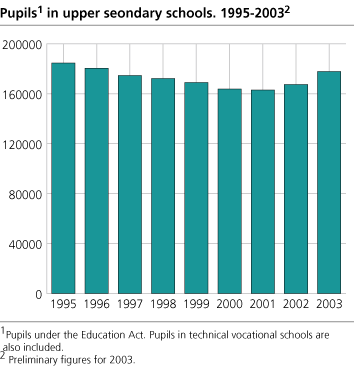Content
Published:
This is an archived release.
Highest increase in health and social studies
Preliminary figures for the school year 2003/2004 show that health and social studies is very popular among pupils. About 20 000 pupils chose this field of study in 2003, an increase of over 3 500 from the previous year.
The total number of pupils in upper secondary education has risen in the last two years but not all fields of study have been affected by this trend. General economic and management studies still has the largest number of pupils but experienced only a slight increase from the previous year. The number of pupils in health and social studies has increased most from 2002 to 2003 compared with other fields of study. Engineering and mechanical trades is also an attractive field of study with an increase of 1 500 pupils in 2003 compared to 2002. Preliminary figures for the school year 2003/2004 indicate that media and communication is also among the favourites attracting about 3 900 pupils as compared to 3 000 in 2002.
There is still a decline in the number of pupils in the general fields of study compared to the vocational areas of study. Approximately 51 per cent chose general fields of study in 2003, a decrease of two percentage points from 2002. Both men and women to a large extent prefer vocational studies. The women proportion in vocational studies rose from 44 per cent in 2002 to 46 per cent in 2003. The equivalent proportion for men is 50 per cent and 52 per cent respectively. A possible explanation for this trend is the introduction of media and communication studies and sales and service trades.
Increasing number of pupils
Preliminary figures show that 178 000 pupils were enrolled by 1 October 2003, about 10 400 more than that of 2002 and 15 000 more than figures from 2001. This represents an increase of 6 per cent from 2002 and 9 per cent from 2001. One of the reasons for the increase is the inclusion of mature pupils from adult education programmes.
Pupils in music, dance and drama have parents with high education
There are differences in respect to parents' educational level and choice of education. Almost 65 per cent of pupils in music dance and drama have parents with tertiary education. Only 14 per cent of pupils in health and social studies have parents with tertiary education. An equally high portion have only primary and lower secondary education.
Most pupils per class in Oslo and Oppland
Preliminary figures by 1 October 2003 presents 466 upper secondary schools in Norway with 397 county schools, 3 state schools and 66 private schools. The figures include schools that offer courses in general, technical and vocational subjects with more than 10 pupils. Technical vocational schools are also included.
There were almost 9 000 upper secondary classes registered in autumn 2003. The average was 19.8 pupils per class. The number of pupils per class has increased over the last few years. The average for 2001 was 18.6 pupils per class and 18.9 in 2002. Oslo and Oppland had the highest number of pupils per class in 2003 with 24.5 and Nord -Trøndelag followed closely with 23.1 number of pupils per class. Finnmark had the lowest number with 11.7 pupils per class.
Tables:
- Table 1 Pupils in upper secondary education, by grade, gender and county of residence. 1 October 2003. Preliminary figures
- Table 2 Pupils in upper secondary education, by age, gender and county of residence. 1 October 2003. Preliminary figures
- Table 3 Pupils in upper secondary education, by type of education, gender and field of study. 1 October 2003. Preliminary figures
- Table 4 Pupils in upper secondary education, by gender and field of study. 1 October 2003. Preliminary figures
- Table 5 Pupils in vocational study in school, by gender and field of study. 1 October 2003. Preliminary figures
- Table 6 Pupils in upper secondary education by fields of study and parents education level. 1 October 2003. Preliminary figures
- Table 7 Pupils in upper secondary education by gender, areas of study and ownership. 1 October 2003. Preliminary figures
- Table 8 Number of pupils per class in upper secondary schools. 1 October 2003. Preliminary figures
- Table 9 Number of upper secondary schools , by ownership. 1 October 2003. Preliminary figures
The statistics is published with Upper secondary education.
Contact
-
Statistics Norway's Information Centre
E-mail: informasjon@ssb.no
tel.: (+47) 21 09 46 42

